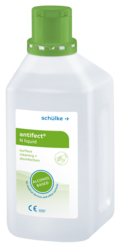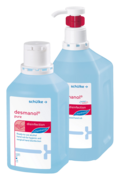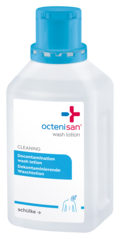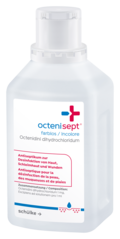Latest news
 60 seconds with Patrick, Medical Director at Vesismin Health by schülke!Today he gives you exciting insights into his day-to-day work and shows you which tasks and projects make up his varied daily routine.
60 seconds with Patrick, Medical Director at Vesismin Health by schülke!Today he gives you exciting insights into his day-to-day work and shows you which tasks and projects make up his varied daily routine. schülke HR Recruiter TippsAt schülke, we don’t just hire for skills—we hire for mindset. We value those who act with passion, strive for quality, drive innovation, build trust, and believe in the power of collaboration
schülke HR Recruiter TippsAt schülke, we don’t just hire for skills—we hire for mindset. We value those who act with passion, strive for quality, drive innovation, build trust, and believe in the power of collaboration From Dual Student to Department Lead – Mads Gadeberg’s Journey at schülkeCareer paths at schülke are as diverse as the colleagues – and Mads Gadeberg’s story shows what’s possible when dedication meets trust.
From Dual Student to Department Lead – Mads Gadeberg’s Journey at schülkeCareer paths at schülke are as diverse as the colleagues – and Mads Gadeberg’s story shows what’s possible when dedication meets trust. Call for applications for the Hygiene Prize of the Rudolf Schülke Foundation 2026In March 2026, the Rudolf Schülke Foundation will once again award the Hygiene Prize to scientists who have developed outstanding solutions to problems in the fields of hygiene, public health and infection prevention.
Call for applications for the Hygiene Prize of the Rudolf Schülke Foundation 2026In March 2026, the Rudolf Schülke Foundation will once again award the Hygiene Prize to scientists who have developed outstanding solutions to problems in the fields of hygiene, public health and infection prevention. Job shadowing: New perspectives ensure process optimizationInterdisciplinary and cross-departmental projects are not uncommon in everyday working life. However, the employees involved in a project together often do not know what the team members' jobs actually entail and what their daily work routines look like.
Job shadowing: New perspectives ensure process optimizationInterdisciplinary and cross-departmental projects are not uncommon in everyday working life. However, the employees involved in a project together often do not know what the team members' jobs actually entail and what their daily work routines look like. International Women's Health DayToday, on International Women's Health Day, we would like to highlight a topic that often receives too little attention: Intimate health.
International Women's Health DayToday, on International Women's Health Day, we would like to highlight a topic that often receives too little attention: Intimate health.
Our offer for your industry
 HospitalHygiene is of central importance in hospitals. With schülke's comprehensive disinfection and hygiene solutions, we support you in ensuring the highest standards of infection control and protecting patients and staff.
HospitalHygiene is of central importance in hospitals. With schülke's comprehensive disinfection and hygiene solutions, we support you in ensuring the highest standards of infection control and protecting patients and staff. Personal useProtect yourself and your home with the disinfection and hygiene products from schülke. Reliable solutions for everyday use ensure effective protection and safety.
Personal useProtect yourself and your home with the disinfection and hygiene products from schülke. Reliable solutions for everyday use ensure effective protection and safety. Care homeReliable hygiene is crucial in the care sector in order to protect residents and staff. We offer customized disinfection and hygiene solutions that help prevent infections and ensure the highest safety standards in day-to-day care.
Care homeReliable hygiene is crucial in the care sector in order to protect residents and staff. We offer customized disinfection and hygiene solutions that help prevent infections and ensure the highest safety standards in day-to-day care.
Other sectors
 PharmacyWith schülke products you ensure hygiene and protect customers and employees in your pharmacy.
PharmacyWith schülke products you ensure hygiene and protect customers and employees in your pharmacy. Doctor's practiceProtect your patients and team with high-quality hygiene products from schülke.
Doctor's practiceProtect your patients and team with high-quality hygiene products from schülke. Emergency servicesRely on schülke's high-quality hygiene products in the emergency services to effectively prevent infections and ensure the safety of patients and staff.
Emergency servicesRely on schülke's high-quality hygiene products in the emergency services to effectively prevent infections and ensure the safety of patients and staff. Pharma & cleanroomschülke helps you to meet demanding legal requirements and to optimize your processes in accordance with current legal standards.
Pharma & cleanroomschülke helps you to meet demanding legal requirements and to optimize your processes in accordance with current legal standards.
Products

antifect® N liquid
Alcohol-based, rapid disinfection of non-invasive medical devices and surfaces.
desmanol® pure
Alcohol-based hand rub for hygienic and surgical hand disinfection with panthenol, without colour and perfume
kodan® tincture forte colourless
Ready-to-use skin antiseptic with a long-term effect of at least 24 hours
mikrozid® universal wipespremium
Low-alcohol, rapid disinfection of non-invasive medical devices and surfaces.

For more than 135 years, schülke has stood for pioneering spirit, innovation and quality. Founded by Rudolf Schülke and Julius Mayr in 1889, the Hanseatic disinfectant manufacturer has established itself as an internationally operating and successful company. Today, schülke is one of the market leaders in the areas of infection prevention and hygiene solutions.
Career at schülke
Become part of schülke and shape the future of hygiene and infection prevention with us.




















